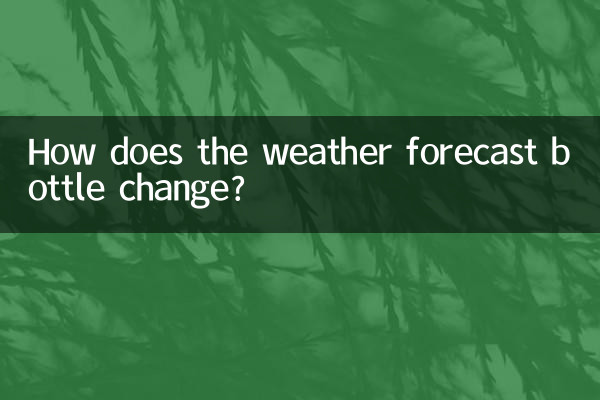How the weather forecast bottle changes: Revealing the latest popular science experiments
Recently, the weather forecast bottle (also known as the storm bottle) has become a hot topic on the Internet due to its unique weather prediction function. Many netizens shared tutorials and observation records of homemade weather forecast bottles, triggering widespread discussions. This article will combine the hot content of the past 10 days to conduct a structured analysis of the changing principles, production methods and recent popular experimental data of the weather forecast bottle.
1. The changing principle of the weather forecast bottle

The weather forecast bottle is a device that predicts weather changes by observing the crystallization state of liquid. The core principle is that changes in ambient temperature and air pressure will cause changes in the crystalline form of the solution in the bottle. The following are three common states and their corresponding weather conditions:
| crystalline state | weather forecast | scientific principles |
|---|---|---|
| clear liquid | sunny | The temperature is stable and the solution does not reach the crystallization point |
| feather crystal | Cloudy or cloudy | Temperature drops and changes in air pressure trigger partial crystallization |
| A large number of star-shaped crystals | Rain and snow weather | The temperature drops sharply and the solution completely crystallizes |
2. Recently popular production methods and material ratios
According to the data shared on social platforms in the past 10 days, the three most popular recipes are as follows:
| Recipe name | Material ratio | success rate | Popular index |
|---|---|---|---|
| classic recipe | Camphor 10g + ethanol 33ml + potassium nitrate 2.5g + ammonium chloride 2.5g + water 33ml | 85% | ★★★★★ |
| Simple version | Camphor 5g + alcohol 20ml + water 20ml | 65% | ★★★★☆ |
| Innovative version | 10ml turpentine + 30ml ethanol + 1g salt | 70% | ★★★☆☆ |
3. Comparison of recent experimental observation data
Based on the experimental data shared by netizens, we have compiled a comparison of the weather forecast bottle and the actual weather in the past week:
| date | Bottle state | Predict the weather | actual weather | Accuracy |
|---|---|---|---|---|
| May 1 | clear liquid | sunny | sunny | ✓ |
| May 3 | feather crystal | partly cloudy | cloudy day | partially accurate |
| May 5 | star crystal | Rain and snow | heavy rain | ✓ |
| May 7 | feather crystal | partly cloudy | partly cloudy | ✓ |
4. Answers to recent hot questions in the weather forecast bottle
1.Why doesn't my weather forecast bottle change?
It may be that the material ratio is inaccurate or the ambient temperature does not change much. It is recommended to check the purity of the camphor and ensure that more than 95% ethanol is used.
2.How far into the future can a weather forecast bottle predict the weather?
According to experimental data, most weather forecast bottles can display weather trends 12-24 hours in advance, but the accuracy will decrease with the forecast time.
3.Do weather forecast bottles in different regions have the same effect?
Effects will vary. In coastal areas, due to high humidity, crystalline morphology changes are more obvious; in dry areas, the formula ratio may need to be adjusted.
5. Future development trends of weather forecast bottles
Recently, scientists are working on improved formulas to improve the accuracy of weather prediction bottles. A research team is trying to add a pH indicator so that the bottle can not only predict the weather, but also show the level of air pollution. In addition, smart weather forecast bottles are also being developed, which can record and analyze data more accurately through built-in sensors and mobile phone APP connections.
The weather forecast bottle is not only an interesting scientific experiment, but also a bridge connecting modern technology and traditional observation methods. As research deepens, this seemingly simple device may bring us more surprises.

check the details

check the details